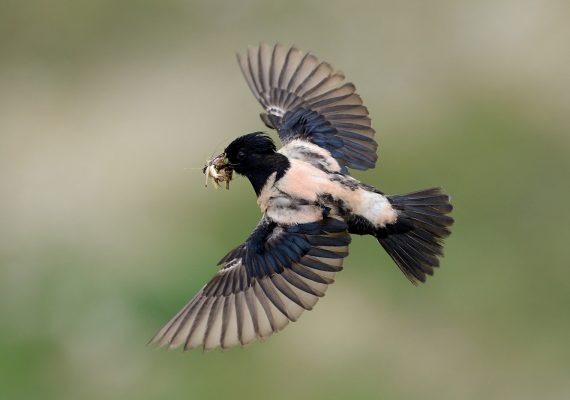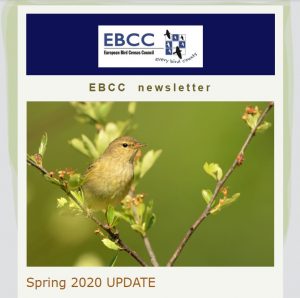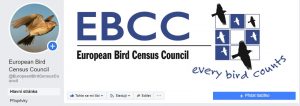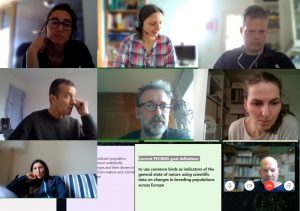Report on the PanEuropean Common Bird Monitoring Scheme, June 2020
August 11, 2020
This report summarizes the activities of the PanEuropean Common Bird Monitoring Scheme (PECBMS) between January 2020 and June 2020.

The title photo of the EBCC Summer Newsletter showing the Rosy Starling (Pastor roseus) was kindly provided by Pavel Štěpánek.
Collection of national species indices
Regular collection of updated national species population trends and indices successfully passed off and national coordinators from 28 European countries sent us their data on 170 common bird species
Publication of the updated common bird indicators
On June 30th we published the new European Common Bird Indicators. This update is based on data from 28 countries, from 1980 up to 2017, and for the first time, the indicators for the year 2018 are estimated using the moving average (running mean). The methods were discussed with Statistics Netherlands and Eurostat. As usual, the indicators were computed for common farmland, common forest, and all common birds on the European level, for the EU and for the European regions (Central & East, South, West, and North Europe). The reason for the estimation is saving time to allow for the general data set revision, which enables us to implement new tools, to clean up the database, and to run various analyses. This way we aim to improve data quality controls and speed up all the processes needed for the production of species trends and indicators in the next years.

The 2020 update of the wild bird indicators was published in June.
Technological development and improvement of data flow and analyses
RTRIM-shell On-line tool (an on-line tool for collecting output files from national coordinators including automatic data quality control) has been improved and communicated via the website. A new on-line tool tutorial was prepared and published. RSWAN (a new program for European species index calculation) was explored and improvements were discussed with our colleagues based at Statistics Netherlands.
Presentation of results and promotion
PECBMS contributed to both EBCC Newsletters published in the reporting period (in March and June and spread to more than 400 recipients, see the archive of the newsletter.


The spring issue of the EBCC electronic newsletter was spread in March. The title photo of the Chiffchaff (Phylloscopus collybita) was kindly provided by Martin Pelánek, www.phototrip.cz. The summer issue was spread in June. The title photo of the Rosy Starling (Pastor roseus) was kindly provided by Pavel Štěpánek.
PECBMS website www.pecbms.info has been actualized on regular basis. Since January 2020 we published six news, updated the publications, PECBMS methods, and the information on the bird monitoring schemes in Europe.
PECBMS news was regularly published on the FB account of EBCC, which serves as a promotional platform for all EBCC projects (39 news since March 4th, when this FB account was launched).

A New EBCC profile has been launched on Facebook.
Research
We have been working on the first PECBMS data paper, which is being prepared for submission in cooperation with the national coordinators of the bird monitoring schemes. The data paper presents an updated European dataset of annual indices and trends for the bird species as well as the methodology used for counting, national and European indices, and trends calculation. Moreover, it provides a brief overview of the applications of the data.
PECBMS data were used in papers published:
- McMahon, BJ, Doyle, S, Gray, A, Kelly, SBA, Redpath, SM 2020:European bird declines: Do we need to rethink approaches to the management of abundant generalist predators? J Appl Ecol.; 00: 1– 6. https://doi.org/10.1111/1365-2664.13695
- , , , , , . Disentangling the relative roles of climate and land cover change in driving the long‐term population trends of European migratory birds. Divers Distrib. 2020; 00: 1– 14. https://doi.org/10.1111/ddi.13144
Maintain and update the network of cooperating organizations and individuals
Up to date, the PECBMS mailing list contains 435 individual contacts from 64 countries or territories, including coordinators of national monitoring schemes, EBCC national delegates, and BirdLife partner organisations as well as policy people and decision-makers. We provided advice and consultations to the national coordinators upon request.
Advice and consultations to the national coordinators were provided upon request.
Reporting and assistance to the main stakeholders of the project, administration
In January we started to work on the EC tender called “Technical and scientific support in relation to the delivery and development of wild bird indicators for the EU“. Czech Society for Ornithology (CSO) is the main tenderer with RSPB, Stichting BirdLife Europe, Catalan Institute for Ornithology (ICO), and University of East Anglia (UEA) as the subcontractors.
In April, we attended the tender kick-off meeting (via on-line conference) and presented the inception report, methods, deliverables, quality measures, and time table of the three-year project.
In February, we delivered the technical and financial report (2019 and final) to EC regarding the grant “New generation of the European Wild Bird Indicators (NGEWBI)” which took place between 2017 and 2019. We successfully finished the grant tasks.
On March 19th, we organised the PECBMS Steering and Technical Group meeting, which was forced to take place via on-line conference instead of the Prague event planned, due to COVID 19 restrictions. There have been several changes in SG and TG groups. Ruud Foppen was replaced by Chris van Turnhout as the representative of SOVON. Zoltan Benkö, the national coordinator of the Common Bird monitoring scheme in Romania from the Romanian Ornithological Society, is a new member. We presented the current major needs of the scheme, mainly the improvements in indicators production, and we agreed to use extrapolation for the 2020 data update. We discussed PECBMS objectives and gaps. The ideas and thoughts were gathered in a document that will serve as a starting point for further discussion during the next meeting dedicated to the production of the official PECBMS Strategy document.

PECBMS Steering Group met on-line for the first time.
On April 21st–22th, we attended the EBCC Board meeting and on June 6th we attended the EBCC Annual General Meeting. We presented the PECBMS agenda since the last meeting as well as the plans for the year 2020.
On June 25th we attended a meeting with DG Agri and discussed the CAP Impact indicators for biodiversity.
Personnel issues
Jana Škorpilová and Anna Gamero have been working part-time on the data revision. We appreciate their notable cooperation.